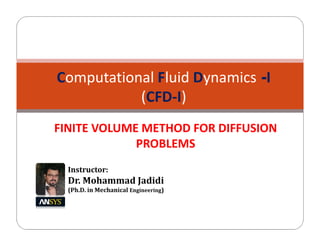Dr jadidi fluent-basic-m01-b
- 1. I-Computational Fluid Dynamics (CFD-I) FINITE VOLUME METHOD FOR DIFFUSION PROBLEMS Instructor: Dr. Mohammad Jadidi (Ph.D. in Mechanical Engineering)
- 2. 2 The governing equation of steady diffusion can easily be derived from the general transport equation The control volume integration, which forms the key step of the finite volume method that distinguishes it from all other CFD techniques, yields the following form: GaussŌĆÖs divergence theorem
- 3. 3 Finite volume method for one-dimensional steady state diffusion Step 1: Grid generation Step 2: Discretisation Step 3: Solution of equations ’ü▒ The first step in the finite volume method is to divide the domain into discrete control volumes(cells). ’ü▒ The boundaries (or faces) of control volumes are positioned mid-way between adjacent nodes. ’ü▒ It is common practice to set up control volumes near the edge of the domain in such a way that the physical boundaries coincide with the control volume boundaries Step 1: Grid generation
- 4. 4 system of notation A general nodal point is identified by P and its neighbours in a one- dimensional geometry, the nodes to the west and east, are identified by W and E respectively. The west side face of the control volume is referred to by w and the east side control volume face by e. The distances between the nodes W and P, and between nodes P and E, are identified by ╬┤xWP and ╬┤xPE respectively. Similarly distances between face w and point P and between P and face e are denoted by ╬┤xwP and ╬┤xPe respectively. shows that the control volume width is Ōłåx=╬┤xwe.
- 5. 5 Step 2: Discretisation Above equation states that the diffusive flux of Žå leaving the east face minus the diffusive flux of Žå entering the west face is equal to the generation of Žå, i.e. it constitutes a balance equation for Žå over the control volume.
- 6. 6 In practical situations, as illustrated later, the source term S may be a function of the dependent variable. In such cases the finite volume method approximates the source term by means of a linear form
- 7. 7 Step 3: Solution of equations ’āś Discretised equations must be set up at each of the nodal points in order to solve a problem. ’āś For control volumes that are adjacent to the domain boundaries the general discretised equation is modified to incorporate boundary conditions. ’āś The resulting system of linear algebraic equations is then solved to obtain the distribution of the property Žå at nodal points. ’āś Any suitable matrix solution technique may be enlisted for this task.
- 8. 8 Examples #1: one-dimensional steady state diffusion Thermal conductivity equals 1000 W/m.K, cross-sectional area A is 10 ├Ś10ŌłÆ3m2 Step 1: Grid generation ╬┤x=0.1 m
- 9. 9 Step 2: Discretisation 1- the discretised equation for nodal points 2, 3 and 4 is Nodes 1 and 5 are boundary nodes, and therefore require special attention.
- 10. 10 2- control volume surrounding point 1 gives discretised equation for boundary node 1:
- 11. 11 The control volume surrounding node 5 can be treated in a similar manner discretised equation for boundary node 5:
- 12. 12 Step 3: Solution of equations
- 13. 13 exact solution and the numerical results coincide exact solution
- 14. 14 Finite volume method for two-dimensional diffusion problems
- 15. 15
- 16. 16
- 17. 17 Finite volume method for three-dimensional diffusion problems

















